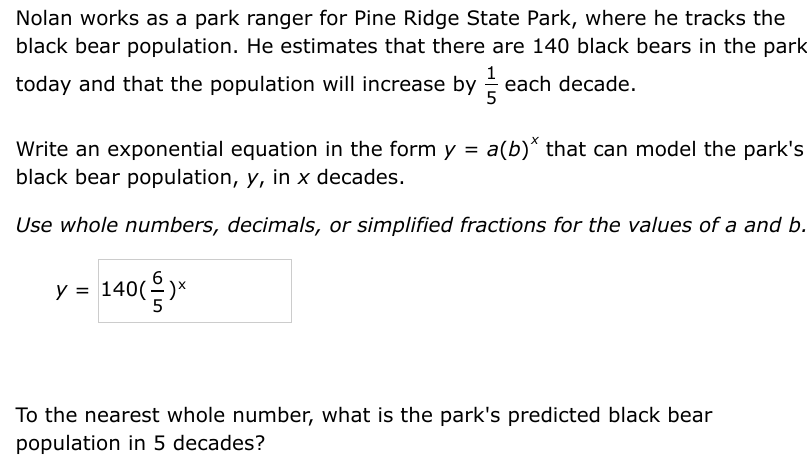Nolan works as a park ranger for Pine Ridge State Park, where he tracks the black bear population. He estimates that there are 140 black bears in the park today and that the popula... Nolan works as a park ranger for Pine Ridge State Park, where he tracks the black bear population. He estimates that there are 140 black bears in the park today and that the population will increase by 1/5 each decade. Write an exponential equation in the form y = a(b)^x that can model the park's black bear population, y, in x decades. To the nearest whole number, what is the park's predicted black bear population in 5 decades?

Understand the Problem
The question is asking to create an exponential equation to model the increase of the black bear population, and then to predict the population after 5 decades using that equation. The key concepts include initial population, growth factor, and time in decades.
Answer
The park's predicted black bear population in 5 decades is approximately $348$.
Answer for screen readers
The predicted black bear population after 5 decades is approximately (348).
Steps to Solve
- Identify initial population and growth factor
The initial population of black bears is given as (a = 140). The growth factor is expressed as (b = 1 + \text{growth rate}). In this case, the growth rate is ( \frac{1}{5} ) or (0.2).
- Calculate the growth factor
The growth factor (b) can be calculated as: $$ b = 1 + \frac{1}{5} = 1.2 $$
- Write the exponential equation
Now, substituting the values for (a) and (b) into the equation (y = a(b)^x): $$ y = 140(1.2)^x $$
- Predict the population after 5 decades
To find the predicted population, substitute (x = 5) into the equation: $$ y = 140(1.2)^5 $$
- Calculate the value
Now, we compute ( (1.2)^5 ): $$ (1.2)^5 \approx 2.48832 $$ Then multiply by 140: $$ y \approx 140 \times 2.48832 \approx 348.38 $$
- Round to the nearest whole number
Rounding (348.38) to the nearest whole number gives: $$ y \approx 348 $$
The predicted black bear population after 5 decades is approximately (348).
More Information
This equation models exponential growth, which is common in biological populations when resources are plentiful. The growth rate of ( \frac{1}{5} ) means the population increases by 20% every decade, illustrating the rapid expansion typical of wildlife in supportive ecosystems.
Tips
- Misunderstanding the growth factor: Always ensure that you convert the growth rate correctly into the growth factor (b) by adding 1.
- Forgetting to apply the exponent: Ensure you raise the growth factor to the power of (x) for the correct decade count.
AI-generated content may contain errors. Please verify critical information